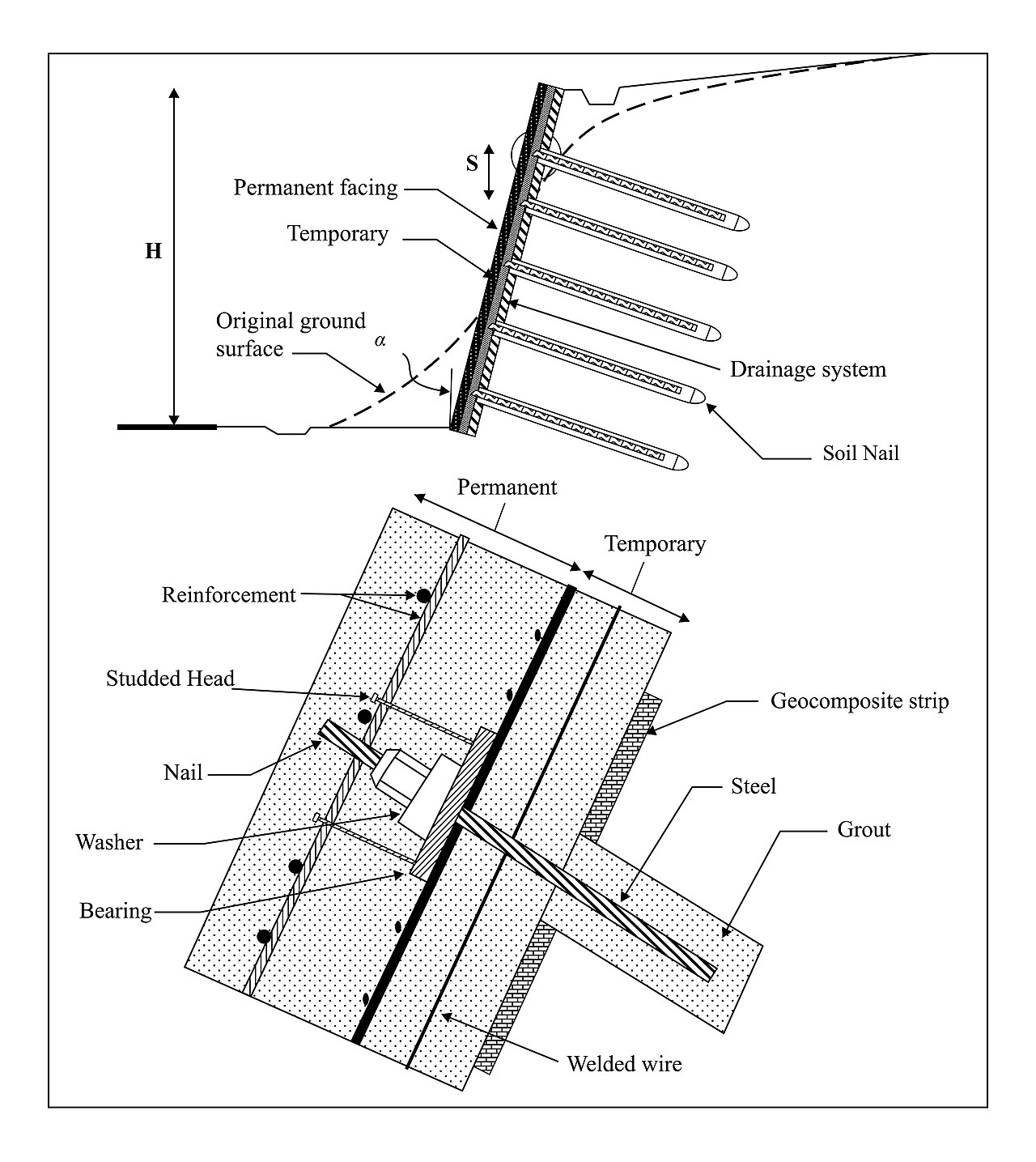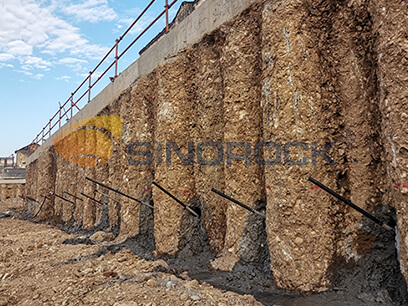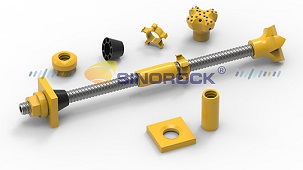What Is a Soil Nail Wall? Soil Nail Wall Types and Construction Techniques
Time:2023-05-07From:sinorock View:
In order to meet the requirements of high-rise buildings, deep foundation need to be excavated during construction. Deep foundation engineering has the characteristics of high difficulty, large amount of work, high risk and easy impact on the surrounding environment. The deep foundation soil nail wall support system is a kind of soil nails installed in the in-situ soil to increase the shear resistance of the in-situ soil. After the soil nails and the in-situ soil form a whole, steel bars are laid on the slope, and then sprayed concrete to protect the slope of the foundation. Soil nail wall support system is widely used in deep foundation support because of its simple construction, low cost and fast construction speed.What Is Soil Nail Wall?
Soil nail wall is an in-situ soil reinforcement technique. The slope of the foundation is reinforced by soil nails made of steel bars or other material such as self drilling anchor system, a steel mesh is laid on the surface of the slope, and then a layer of concrete surface layer is sprayed. Its structure is a complex formed by the reinforcement rods (i.e. soil nails or rock bolts) set in the slope and the surrounding soil, and a support structure similar to a gravity retaining wall formed by the slope facing.
Soil nails are slender rods, such as steel bars or steel pipes or self drilling anchor bolts, that are placed in the in-situ soil at a relatively close distance, and are usually wrapped with cement mortar or cement grout. The characteristic of the soil nail is that it contacts with the surrounding soil along the entire length, acts as a group, and forms a composite with the surrounding soil. Under the condition of slight deformation of the soil, the soil nail is passively stretched and deformed through the cohesive force or friction force on the contact interface with the soil, and the soil is mainly restrained and reinforced or stabilized through the tension work.

Types of Soil Nail Wall
According to the construction technology of soil nailing wall and the construction materials used, soil nailing wall is mainly divided into the following four types:
l Drilling and grouting soil nail
l Driven soil nail
l Driven and grouting soil nail
l Self-drilling soil nails
Supporting Features of Soil Nail Wall
As a widely used support system, soil nail wall has the following five characteristics compared with other support structures:
l The self-supporting capacity of the soil can be reasonably utilized, and the soil can be used as an integral part of the support structure;
l Light structure, high flexibility, good shock resistance and ductility;
l The construction is convenient and safe, and the production and hole forming of soil nails are simple and easy, and flexible, so that it is convenient to change the design in time according to the deformation data and special conditions monitored on site;
l The construction does not need to occupy a separate site. This technology shows unique advantages when the construction site is narrow and large slope protection construction equipment cannot enter the site;
l Due to the small hole diameter, compared with construction methods such as piles, the ability to penetrate pebbles, boulders and rockfill layers is stronger; and the construction is convenient and flexible, and construction is not affected by irregular excavation surface shapes and slope slopes Influence.

Structural Requirements for Soil Nail Wall
The soil nail wall is generally composed of three parts: soil nail system, facing system, and drainage system. In order to ensure the safety of the soil nail wall structure during construction, the following points need to be met:
(1) The technical regulations for foundation support stipulate that the slope of the soil nail wall should not be greater than 1:0.1
(2) The soil nails must be effectively connected to the facing system, and structural measures such as pressure bearing plates or reinforced steel bars should be provided, and the pressure bearing plates or reinforced steel bars should be connected to the soil nails with bolts or steel bars;
(3) The length of soil nails should be 0.5~1.2 times of the excavation depth, the spacing should be 1~2m, and the angle with the horizontal plane should be 5°~20°;
(4) HRB335 and HRB400 steel bars should be used for soil nailing reinforcement, the diameter of the reinforcement should be 16~32mm, and the diameter of the drilling hole should be 70~120mm; if use self drilling anchor bolts, R25, R32 and R38 soil nails are common types;
(5) The grouting material for the soil nail wall should be cement grout or cement mortar, and its strength grade should not be lower than M20;
(6) The shotcrete surface layer of the soil nail wall should be equipped with steel mesh, the steel bar diameter should be 6~10mm, the spacing should be 150~300mm, the shotcrete strength grade should not be lower than C20, and the surface layer thickness should not be less than 80mm;
(7) The overlapping length of the reinforcement mesh on the upper and lower sections of the soil nail wall slope should be greater than 300mm.
Soil Nail Wall Construction Technology
(1) Foundation Excavation
For excavation, excavation equipment and methods that have little disturbance to the slope soil should be selected, and over-excavation of the side wall or loosening of the side wall soil is strictly prohibited. After the slope is excavated by machinery, small machinery or shovels should be used to cut and clear the slope, so that the slope and the flatness of the glass surface can meet the design requirements.
(2) Spray the first surface layer
The spraying operation should be carried out in sections, and the spraying sequence in the same section should be sprayed from bottom to top, and the thickness should not be less than 40mm.
(3) Drilling, installing soil nails and grouting
For the setting of soil nails, for steel nails, holes are usually formed in the soil first, and then the soil nail steel bars are placed and grouted along the full length. For steel pipe nails, it is driven into soil and then grouted from the steel pipe.
The soil nailing hole is drilled with a bolt engineering drilling rig. It is strictly forbidden to use water drilling during the drilling process to prevent the surrounding geological conditions from deteriorating. When opening the hole, it is aligned with the hole position and drilled slowly. When the footage reaches a certain depth and the soil layer is relatively stable, Only then can the drilling be accelerated, and the wear of the drill bit should be checked at any time during the drilling process to prevent the hole diameter from not meeting the design requirements.

Summary
The above introduction to the soil nail wall is mainly for the traditional soil nail wall. When encountering complex strata such as cobblestone, loose soil, gravel, miscellaneous fill and other unstable strata, self-drilling anchor bolts can be used instead of traditional ones. Soil nailing materials are used to make soil nail walls. The main feature of the self-drilling anchor bolt is that it can be drilled and grouted simultaneously without pulling out the drill rod, which can save construction costs and shorten the construction period while reducing the construction process. It is already an alternative to unstable formations. If you need to know more, welcome to contact sinorock@sinorockco.com at any time.
latest news
-

- What Are the Applications of SDA Bolts in Hydropower Stations?
- Time:2025-08-21From:This Site
- Learn how self-drilling anchor bolts enhance slope stability, tunnel support, and dam reinforcement in complex geological conditions at hydropower stations. Optimize hydropower projects with efficient, cost-effective, and eco-friendly solutions.
- View details
-

- Slope Stabilization with SDA Bolts: Benefits & Applications
- Time:2025-08-19From:This Site
- Discover how self-drilling anchor bolts (SDA bolts) provide superior slope stabilization for highways, railways, and tunnels. Learn their key benefits, installation process, and real-world applications in loose or collapsible soils.
- View details
-

- How Self-Drilling Rock Bolts Enhance Tunnel Support in Fractured Rock?
- Time:2025-08-15From:This Site
- Discover how self-drilling rock bolts enhance tunnel support in fractured rock. Learn their benefits, installation steps, and real-world applications for safe, efficient tunneling.
- View details
-

- Sinorock 2025 Quality Month | Strengthening Quality Foundations, Empowering Product Excellence
- Time:2025-08-13From:This Site
- Sinorock’s 2025 Quality Month, themed “Strengthening Quality Foundations, Empowering Product Excellence,” successfully concluded, reinforcing our commitment to superior product quality.
- View details
-

- Sinorock Safety Month 2025 | Everyone Speaks Safety, Everyone Can Respond
- Time:2025-07-03From:This Site
- Sinorock Safety Month 2025, centered on the theme "Everyone Speaks Safety, Everyone Can Respond - Spot Workplace Hazards," has wrapped up successfully!
- View details
-

- Quality Control: the Vital Factor of A SDA Bolt Factory
- Time:2025-01-09From:This Site
- Sinorock’s comprehensive quality control system, from supplier management to outgoing inspections, ensuring the highest standards for self-drilling anchor bolts in construction.
- View details
-

- Sinorock Invites You to Explore Proven Self-Drilling Anchor Bolt Solutions at bauma 2025
- Time:2025-03-07From:This Site
- From April 7–13, 2025, explore Sinorock’s Self-drilling anchor bolt solution at Booth C2.513/4 in Hall C2 of the Messe München Exhibition Center (Munich, Germany).
- View details
-
.jpg)
- SINOROCK to Attend EXPOMINA PERÚ 2024 in Lima, Peru
- Time:2024-08-10From:This Site
- Sinorock to Attend EXPOMINA PERÚ 2024 in Lima, Peru
- View details
-
.jpg)
- SINOROCK to Participate in MINING AND METALS CENTRAL ASIA 2024
- Time:2024-08-08From:This Site
- SINOROCK to Participate in MINING AND METALS CENTRAL ASIA 2024
- View details
 Download
Download 


